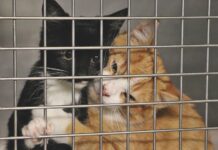Tooth resorption, still sometimes referred to as feline odontoclastic resorptive lesions or FORLs, is a common and painful condition affecting cats’ teeth. In cats with this condition, one or more teeth slowly break down and resorb, exposing the pulp of the tooth. Estimates of how many cats are affected by tooth resorption range from 20 to 60 percent.
What Happens
Your cat’s teeth are made up of several layers, just like yours. The outer, hardest layer is enamel, which protects the rest of the tooth. The thickest layer is dentin, a firm, somewhat bony material. The innermost layer is the pulp, which contains blood vessels and nerve endings. Normally, the dentin and enamel protect the pulp from the outside world.
When tooth resorption occurs, cells called odontoclasts break down the dentin layer of the tooth. This exposes the pulp, which can then be damaged by food debris and even the normal pressure of chewing. If you have ever had a bad cavity or a broken tooth, you know how painful this can be!
Eventually, the entire tooth will disintegrate and be resorbed by the body. Some cats will only have one tooth affected, while other cats may lose their entire set of teeth. The rate of resorption varies from cat to cat and sometimes tooth to tooth.
Unknown Cause
At this point in time, the cause of tooth resorption in cats is unknown. Odontoclasts are cells that occur normally (they are responsible for breaking down the roots of baby teeth to allow them to fall out), but we don’t know why they sometimes go haywire. One theory blames excess vitamin D in cats’ diets.
Signs
Tooth resorption often goes unnoticed by owners due to cats’ stoic tendencies.
Things to watch for that indicate your cat may be suffering from tooth resorption:
-Swallowing kibbles whole rather than chewing
-Dropping food
-Tilting head to chew food on one side
-Reluctance to eat, especially hard food
-Decreased interest in picking up toys
-Crying when chewing
-Pain when mouth is touched
-Drooling
-Bleeding from the mouth
-Missing teeth
-Teeth that appear damaged
Chewing abnormalities are the most common sign that you may observe as an owner. In severe cases, a cat may stop eating completely.
If your cat allows you to look at his teeth, watch for small holes (especially if they get larger over time), jagged missing pieces of teeth, and teeth that seem to be covered by angry red gum tissue. This last sign is the body attempting to protect the tooth pulp with gum tissue since the dentin and enamel are gone.
Diagnosis
An oral exam should be part of your cat’s annual veterinary visit. Your veterinarian will gently pull back your cat’s lips to view his teeth and will open the cat’s mouth to get a view of the tongue and back of the mouth. If your cat is cooperative, your veterinarian will see any holes present on the outside of the teeth or other signs of inflammation. A full oral exam under anesthesia will allow your veterinarian to see all sides of the teeth and to measure any pockets between the teeth and gums.
The best way to diagnose tooth resorption is to do dental radiographs. This allows your veterinarian to view the entire tooth, including the roots beneath the gumline. Dental radiographs will require your cat to be sedated or anesthetized to keep him still and to protect the equipment.
Treatment
Treatment is to extract the affected tooth. This removes the source of discomfort and allows the gum tissue to heal over. If your veterinarian or technician comes across a resorptive lesion during a routine dental cleaning, and extractions had not been discussed beforehand, he or she will call to get your permission to remove the tooth. Extractions range from easy to difficult. Canines and three-rooted teeth are the most difficult to extract, and resorption makes it more likely that the tooth will fracture during extraction.
In some cases, it may be decided to leave a tooth that only shows minor damage and remove it if it becomes a problem. This usually happens when a tooth appears to be in generally good health but shows signs of resorption on x-ray.
If your cat has multiple extractions, don’t worry. The mouth usually heals quickly, and your cat will be far more comfortable with the bad teeth removed than he was with them in his mouth. He will need to eat soft food during the initial healing process, but many cats are able to go back to their regular dry food without problems, even if they are missing several teeth.
Prevention
The bad news is that until we know the cause of tooth resorption, it is difficult to say how to prevent it from happening. The good news is that routine dental care, such as daily brushing, has plenty of other benefits for your cat’s oral and overall health. The brushing action is more important than the toothpaste itself, so don’t worry if your cat objects to the toothpaste.



